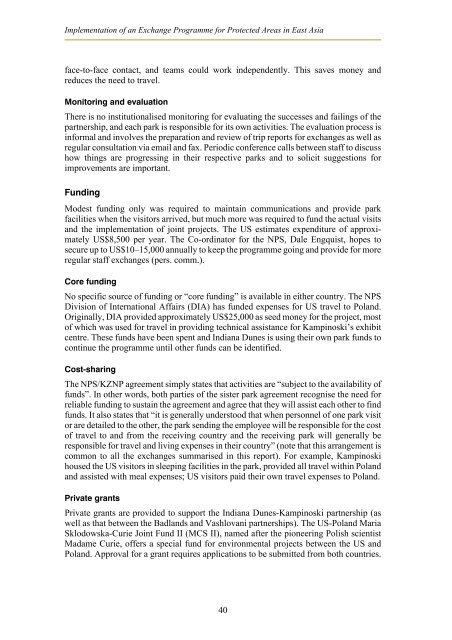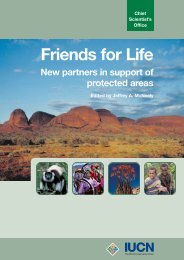Exchange programmes - IUCN
Exchange programmes - IUCN
Exchange programmes - IUCN
You also want an ePaper? Increase the reach of your titles
YUMPU automatically turns print PDFs into web optimized ePapers that Google loves.
Implementation of an <strong>Exchange</strong> Programme for Protected Areas in East Asia<br />
face-to-face contact, and teams could work independently. This saves money and<br />
reduces the need to travel.<br />
Monitoring and evaluation<br />
There is no institutionalised monitoringfor evaluatingthe successes and failings of the<br />
partnership, and each park is responsible for its own activities. The evaluation process is<br />
informal and involves the preparation and review of trip reports for exchanges as well as<br />
regular consultation via email and fax. Periodic conference calls between staff to discuss<br />
how things are progressing in their respective parks and to solicit suggestions for<br />
improvements are important.<br />
Funding<br />
Modest fundingonly was required to maintain communications and provide park<br />
facilities when the visitors arrived, but much more was required to fund the actual visits<br />
and the implementation of joint projects. The US estimates expenditure of approximately<br />
US$8,500 per year. The Co-ordinator for the NPS, Dale Engquist, hopes to<br />
secure up to US$10–15,000 annually to keep the programme going and provide for more<br />
regular staff exchanges (pers. comm.).<br />
Core funding<br />
No specific source of fundingor “core funding” is available in either country. The NPS<br />
Division of International Affairs (DIA) has funded expenses for US travel to Poland.<br />
Originally, DIA provided approximately US$25,000 as seed money for the project, most<br />
of which was used for travel in providingtechnical assistance for Kampinoski’s exhibit<br />
centre. These funds have been spent and Indiana Dunes is usingtheir own park funds to<br />
continue the programme until other funds can be identified.<br />
Cost-sharing<br />
The NPS/KZNP agreement simply states that activities are “subject to the availability of<br />
funds”. In other words, both parties of the sister park agreement recognise the need for<br />
reliable funding to sustain the agreement and agree that they will assist each other to find<br />
funds. It also states that “it is generally understood that when personnel of one park visit<br />
or are detailed to the other, the park sendingthe employee will be responsible for the cost<br />
of travel to and from the receivingcountry and the receivingpark will generally be<br />
responsible for travel and livingexpenses in their country” (note that this arrangement is<br />
common to all the exchanges summarised in this report). For example, Kampinoski<br />
housed the US visitors in sleepingfacilities in the park, provided all travel within Poland<br />
and assisted with meal expenses; US visitors paid their own travel expenses to Poland.<br />
Private grants<br />
Private grants are provided to support the Indiana Dunes-Kampinoski partnership (as<br />
well as that between the Badlands and Vashlovani partnerships). The US-Poland Maria<br />
Sklodowska-Curie Joint Fund II (MCS II), named after the pioneeringPolish scientist<br />
Madame Curie, offers a special fund for environmental projects between the US and<br />
Poland. Approval for a grant requires applications to be submitted from both countries.<br />
40






